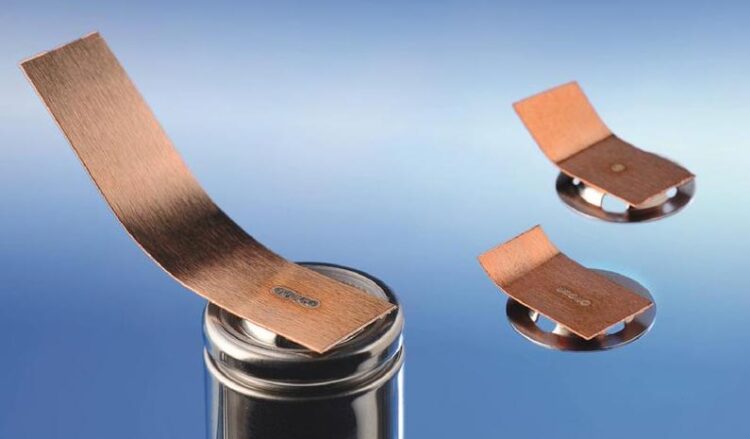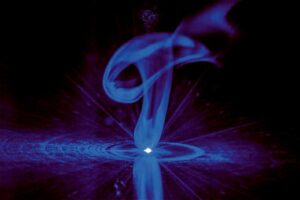HoLiB and MikroPuls: Two Lasers, Two Applications, One Goal …

As part of the AiF project MikroPuls, Fraunhofer ILT is developing laser processes for the efficient contacting of battery cells (pictured: laser-welded copper connectors on cylindrical cells).
© Fraunhofer ILT, Aachen, Germany
Improving the Production of Battery Cells …
Setting up high-performance production centers for battery cells is high on the current agenda of the automotive industry. The Fraunhofer Institute for Laser Technology ILT in Aachen is proactively working towards this goal: In the BMBF project “HoLiB” and the AiF project “MikroPuls”, for example, scientists from Aachen are investigating how laser technology can be used to economically contact and join dissimilar materials.
The trend away from the combustion engine to the electric drive can no longer be stopped. However, it will only be successful if battery cells can be manufactured efficiently and reliably, and if they can be interconnected to form modules and packs in order to dependably cover the upcoming large demand for storage capacity.
Efficiency boost for lithium-ion batteries

© Fraunhofer ILT, Aachen, Germany
For example, processes are required with which lithium-ion batteries can be manufactured much more productively than before. The BMBF project “HoLiB – High throughput processes for the production of lithium ion batteries” of the Competence Cluster for Battery Cell Production (ProZell) focuses on employing new technologies for assembly, stack formation and contacting as well as cutting out activities that do not add value, all within the entire process chain. The TU Braunschweig is developing a laser punching process for cutting the electrodes from a continuously guided material web in milliseconds. A rotating stacking wheel places anode and cathode-separator assemblies individually and stacks them alternately in a magazine.
Successful tests with three beam sources
This is where Fraunhofer ILT comes in: It is developing and qualifying a laser process that can be used to connect anodes and cathodes to the contacts: the arrester tabs. Because the anodes are made of copper, the cathodes of aluminum and the arrester tabs of both materials, the Aachen researchers decided to test three different beam sources. A blue diode laser (wavelength: 450 nm), a green disk laser (515 nm) and an infrared fiber laser (1070 nm) are being used. “We are investigating which beam source is best suited for which joining task”, explains Johanna Helm, a research associate at the Fraunhofer ILT. “The test of the three beam sources has already shown that the film stack can be welded through with process reliability. We are currently verifying the process windows and carrying out welding tests on the arrester tabs.”
The scientist also suggested using a turntable with several stations on which the electrodes can be stacked for contacting. The 20 anodes and cathodes are stacked by a stacking wheel at 0.1-second intervals so that a stack is ready within two seconds. When a stack is at a station on the turntable, the turntable continues to rotate rapidly so that the rotating stacking wheel can deposit further anodes and cathodes on the next free space. In parallel, the laser-based contacting process for the first deposited stack can start without any loss of time.
Nanosecond laser pulses protect heat-sensitive components
In the AiF project MikroPuls, scientists are examining how to bond battery cells more efficiently. With the support of industrial partners, Fraunhofer ILT is developing processes for joining copper, aluminum and steel with an infrared fiber laser pulsed in the nanosecond range.
These are demanding processes because the thin electrical contacts are thermally sensitive and may not be heated too much. A balance is important here: If too little welding energy is applied, the connection lacks mechanical stability; if too much energy is applied, the batteries’ mode of operation is impaired or their service life is shortened. “Some sensitive electrolytes are already destroyed at 60°C”, explains Elie Haddad, research associate at Fraunhofer ILT. “This is where the fast MikroPuls process can play out its advantages, which can even be used to generate copper welds at a maximum average power of 200 watts while introducing little energy into the components.”
Reliable laser welding of dissimilar materials
The dissimilar joints between copper and aluminum, for example, also pose a particular challenge. Haddad explains: “Here, intermetallic phases form quickly, which deteriorate the quality of the weld seam. They can lead, for example, to high contact resistances that result in either high losses due to heat or brittle joints that can no longer withstand mechanical forces.” The experts use tensile shear experiments and SEM images to analyze the results of the welding tests, also to reduce the intermetallic phases. An important role is played by selectively identifying the optimum parameters with which users can also reliably generate dissimilar joints that have a consistent welding depth and high weld quality.
Tests with copper-aluminum joints on pouch cells and copper-steel joints on cylindrical cells, among others, showed that micro-pulse joining can achieve just as good joints as continuous CW welding – with significantly lower energy consumption, higher repeatability and fewer intermetallic phases. The only disadvantage is that the welding process generally takes longer. So there are still parameters that need to be improved.
The engineers in Aachen already have a system in operation that integrates both a CW fiber laser and a nanosecond pulsed fiber laser. The beam sources can be controlled individually. The system can not only join, but also remove material, for example to structure surfaces.
HoLiB
The following institutes are working on the project “HoLiB – High throughput processes for the production of lithium ion batteries” funded by the German Federal Ministry of Education and Research (BMBF), (duration: Oct. 1, 2019 – Sept. 30, 2022):
– TU Braunschweig, Institute of Machine Tools and Production Technology IWF (Coordinator),
– TU Braunschweig, Institute of Joining and Welding Technology (ifs),
– TU Berlin, Institute for Machine Tools and Factory Management (IWF) and
– Fraunhofer Institute for Laser Technology ILT, Aachen.
For further information, please see www.prozell-cluster.de/en/projects/holib/
MikroPuls
The following companies are involved in the project-accompanying committee for “MikroPuls – Fine contacting of thermally sensitive materials in electrical engineering by means of short laser pulses”, which is funded by the Federal Ministry for Economic Affairs and Energy (BMWi) as well as by the AiF Arbeitsgemeinschaft industrieller Forschungsvereinigungen “Otto von Guericke” e.V. (German Federation of Industrial Research Associations “Otto von Guericke”) and the DVS Deutscher Verband für Schweißen und verwandte Verfahren e. V. (German Welding Society), (duration: Oct. 1, 2019 – Sept. 30, 2021):
– Fraunhofer Institute for Laser Technology ILT, Aachen (Coordinator)
– BBW Lasertechnik GmbH, Prutting
– BLS Lasertechnology GmbH, Grafenau
– Class 4 Laser Professionals AG, Lyss (CH)
– Hugo Kern und Liebers GmbH & Co KG, Schramberg
– Inovan Präzisionsteile GmbH & Co KG, Stolberg
– Copper Consulting Technology Laboratory, Düsseldorf
– LaserJob GmbH, Fürstenfeldbruck
– Laser Microtechnology Dr. Kieburg GmbH, Berlin
– Scansonic MI GmbH, Berlin
– SPI Lasers UK (TRUMPF Laser UK)
Wissenschaftliche Ansprechpartner:
Johanna Helm M.Sc.
Micro Joining Group
Telephone +49 241 8906-8382
johanna.helm@ilt.fraunhofer.de
Elie Haddad M.Sc.
Micro Joining Group
Telephone +49 241 8906-8013
elie.haddad@ilt.fraunhofer.de
Weitere Informationen:
Media Contact
All latest news from the category: Power and Electrical Engineering
This topic covers issues related to energy generation, conversion, transportation and consumption and how the industry is addressing the challenge of energy efficiency in general.
innovations-report provides in-depth and informative reports and articles on subjects ranging from wind energy, fuel cell technology, solar energy, geothermal energy, petroleum, gas, nuclear engineering, alternative energy and energy efficiency to fusion, hydrogen and superconductor technologies.
Newest articles

Superradiant atoms could push the boundaries of how precisely time can be measured
Superradiant atoms can help us measure time more precisely than ever. In a new study, researchers from the University of Copenhagen present a new method for measuring the time interval,…

Ion thermoelectric conversion devices for near room temperature
The electrode sheet of the thermoelectric device consists of ionic hydrogel, which is sandwiched between the electrodes to form, and the Prussian blue on the electrode undergoes a redox reaction…

Zap Energy achieves 37-million-degree temperatures in a compact device
New publication reports record electron temperatures for a small-scale, sheared-flow-stabilized Z-pinch fusion device. In the nine decades since humans first produced fusion reactions, only a few fusion technologies have demonstrated…





















